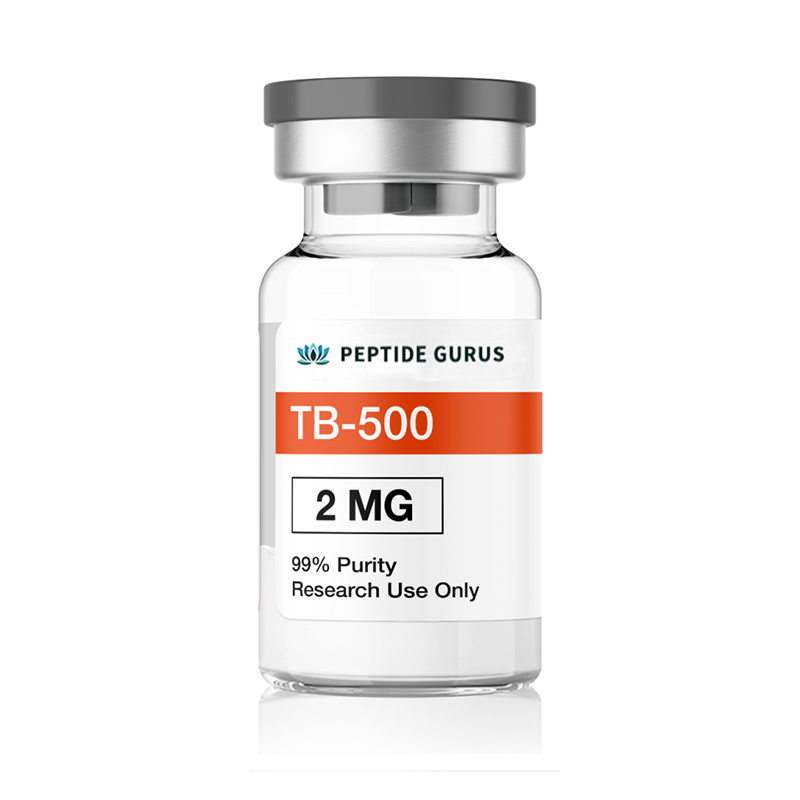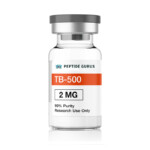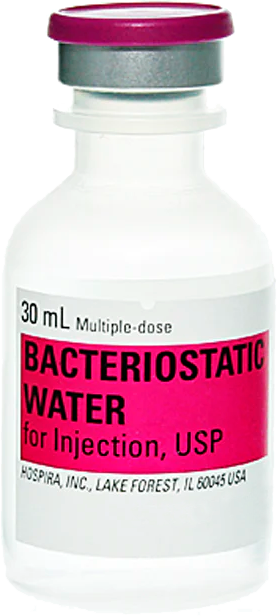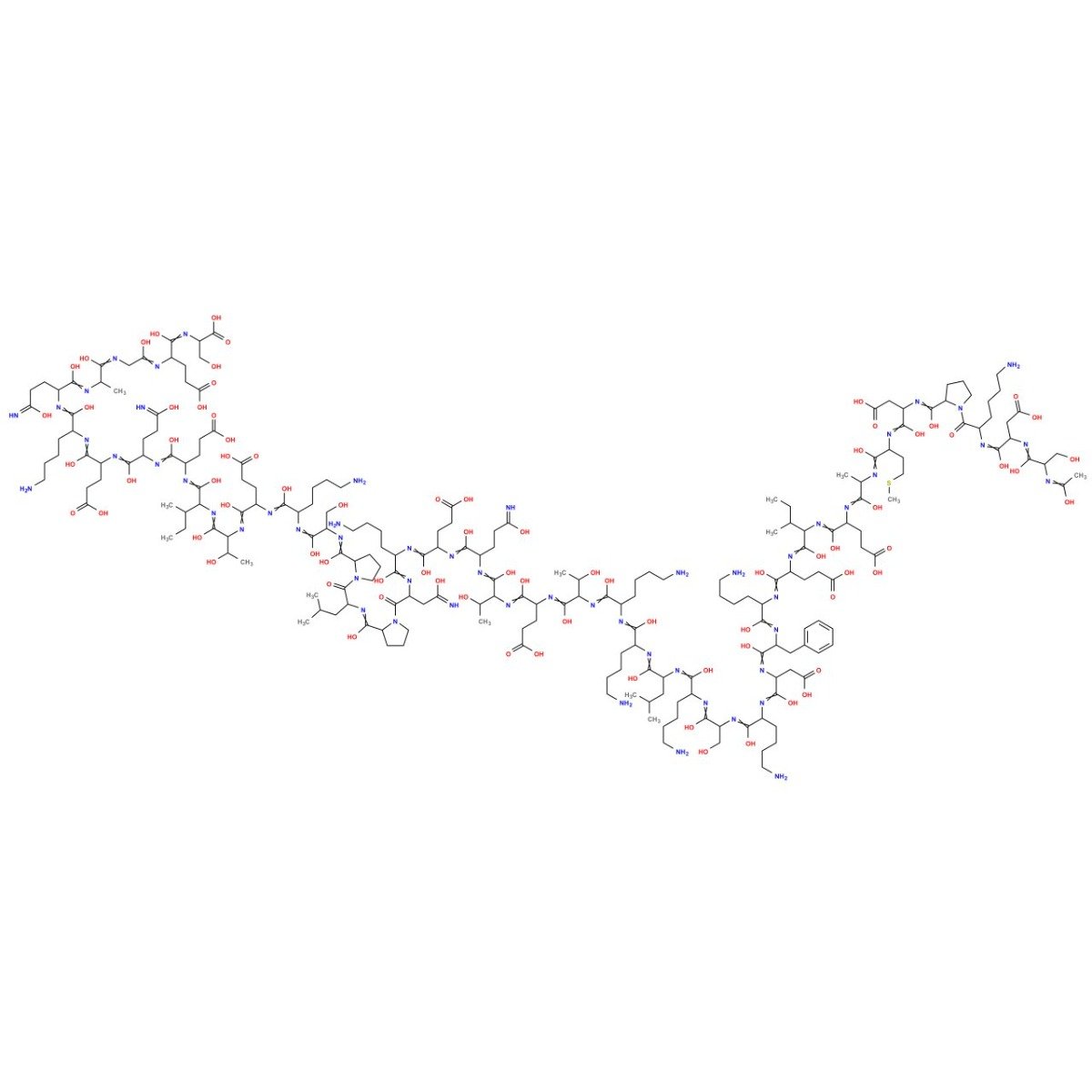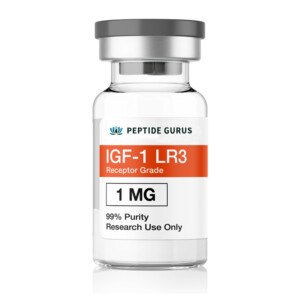Gratis (1) 30 ml de agua bacteriostática
con pedidos calificados sobre $500 Dólar estadounidense.
(excluye productos en cápsulas, péptidos cosméticos, códigos promocionales y envío)
TB-500 (timosina beta-4) es un 43 secuencia peptídica de aminoácidos. En modelos animales, Se ha demostrado que la timosina Beta-4 mejora el crecimiento de los vasos sanguíneos., regular la cicatrización de heridas, disminuir la inflamación, y reducir el daño oxidativo en el corazón y el sistema nervioso central. La timosina-beta-4 tiene un papel en la protección., reparación de tejidos, regeneración y remodelación de tejidos lesionados o dañados. También es de interés activo en la investigación antienvejecimiento..
Uso del producto: Este PRODUCTO ESTÁ DISEÑADO ÚNICAMENTE COMO QUÍMICO DE INVESTIGACIÓN. Esta designación permite el uso de productos químicos de investigación estrictamente para pruebas in vitro y experimentación de laboratorio únicamente.. Toda la información del producto disponible en este sitio web es solo para fines educativos.. La introducción corporal de cualquier tipo en personas o animales está estrictamente prohibida por la ley.. Este producto sólo debe ser manipulado por personal autorizado., profesionales cualificados. Este producto no es un medicamento., alimento, o cosmético y no puede estar mal etiquetado, mal utilizado o mal etiquetado como droga, comida o cosmética.
TB-500 (timosina beta-4)
timosina beta 4, or TB-500, is a synthetic version of a naturally occurring 43-amino acid peptide present in nearly all human and animal cells studied.
A 2010 study in the Annals of the New York Academy of Sciences supported TB500’s potential for cardiac muscle repair following injury, eg, after myocardial infarction (infarto de miocardio). Recognizing the limitations of stem cell therapy for this application, TB500 was found to inhibit myocardial cell death, stimulate blood vessel growth, and activate cardiac processes that encouraged the heart to heal following injury. The investigation showed that TB500 may be the first agent which can actively recover injured cardiac muscle following heart attack. This is further supported with prior mouse studies in 2004 showing cardiomyocyte migration, survival and repair of myocardial damage. [1] [2]
Filamentous actin (F-actin, or actin) forms polymers that thicken sputum, adversely affecting cystic fibrosis patients. TB500 was studied in a population of CF patients, showing a dose- and time-dependent decrease in cohesivity of sputum after administration of TB500 when combined with dornase alfa. The combination therapy showed a 71% improvement in mucociliary transport of mucus, and a 44% improvement in cough transport of mucus. [3]
TB500 is known to stimulate myoblasts and myocytes (muscle generating cells). Mitochondrial RNA levels of TB500 have been shown to increase following muscle injury, helping to regenerate muscle fibers and address inflammation in the injured location. The data support muscle injury causing increased local production of TB500, promoting migration of incoming myoblasts to accelerate skeletal muscle regeneration. [4]
TB-500 (timosina beta-4) 2mg
Secuencia: Ac-Ser-Asp-Lys-Pro-Asp-Met-Ala-Glu-Ile-Glu-Lys-Phe-Asp-Lys-Ser-Lys-Leu-Lys-Lys-Thr-Glu-Thr-Gln-Glu- Lys-Asn-Pro-Leu-Pro-Ser-Lys-Glu-Thr-Ile-Glu-Gln-Glu-Lys-Gln-Ala-Gly-Glu-Ser
fórmula molecular: C212H350N56O78S
masa molar: 4963.4408
número CAS: 77591-33-4
PubChem: CID 16132341
Sinónimos: timosina beta 4
TB-500 Research Studies
A study completed in 2009 using .01% TB500 w/w eye drops demonstrated increased speed of healing following eye surgery in diabetics. This population was specifically investigated due to well known healing complications in diabetics, and their predilection for eye issues, specifically diabetic retinopathy. The study showed no serious side effects in any patient, although headache, dizziness and insomnia occurred more in the study group than the control. Of specific interest, human diabetic retinopathic corneas express substantially less endogenous TB500 than a normal cornea, suggesting an inherent deficiency in ability for diabetics to heal following eye injury or surgery. [5] Similarmente, chronic dry-eye patients were treated with TB500 eye drops, and all in the study had improvement in symptoms, with rare and minimal complications. [6]
TB500 was studied in the setting of chronic hepatitis B combined with nonalcoholic fatty liver disease (NAFLD). While TB500 had no correlation with HepB Virus levels nor liver function tests (AST, ALT, TG), there was a negative correlation with inflammation and fibrosis scores – meaning that the lower the level of TB500, the worse the inflammation and fibrosis. This provided preliminary data that TB500 may be beneficial in the setting of certain liver diseases. [7]
A human voluntary safety and tolerance study was performed in 2010, and showed that intravenous (IV) doses from 42mg up to 1260mg daily for 14 days had no treatment related adverse effects, and no evidence of dose related toxicity. [8]
Rhinovirus (a common cold virus) was introduced to healthy volunteers, and blood tests were taken during a five-day period. This showed that serum cortisol rose along with thymosin alpha 1 and TB500 on the fifth day following intentional exposure. Simultaneously, t-lymphocytes (CD3+), cytotoxic/suppressor (CD8+), and natural killer (CD16+) cells all rose. This suggests a cooperative effect among systemic and cellular immune response related to thymosin and respiratory virus exposure. [9]
Kidney disease often includes inflammation, fibrosis, and complications from diabetes. TB500 has been studied in mice with and without kidney disease; in healthy mice, levels of TB500 did not affect healthy kidney tissue, but in those with known kidney disease, low levels of TB500 correlated with worsening disease. That is, low levels of natural TB500 accelerated kidney disease. The study suggested that endogenous TB500 levels function to protect the kidney and slow disease progression. [10]
TB500 has been studied specifically in healing of skin and wounds, showing acceleration in healing of skin in burns, diabetic ulcers, elderly subjects, pressure ulcers, stasis ulcers, and epidermolysis wounds, in both animal and human subjects. The study shows improvement in angiogenesis (blood vessel formation), anti-inflammatory activity, and to increase platelet aggregation at wound sites. [11]
A meta-analysis (study of studies) conducted in 2015 showed broad applicability of TB500 in various disease processes, including improvement of tissue regeneration, repair of the heart after heart attack, healing of the brain following stroke, trauma and neurological diseases. Further it showed clinical improvement in kidney and liver diseases, and repair of spinal cord, bone and ligament injuries, as well as reducing consequences of aging and viral infection. [12]
TB500 treated mice were found to have substantially improved strength in healed fractures compared to untreated mice. Treated mice showed a 41% increase in peak force to failure, and healed fractures were 25% stiffer than untreated mice. 21-day post-fracture imaging showed improvement up to 26% better than untreated subjects. They also showed 23% smaller callus, and a 31% increase in trabecular bone area/total callus area. Overall TB500 demonstrated substantially faster healing, with better-healed injury sites when compared to placebo subjects. [13]
Spinal cord injury has been studied in rats, with potential applicability to human subjects. In a 2014 study, TB500 was administered to rats 30 minutos, 3 días, o 5 days after mild compression induced spinal cord injury in rats. Locomotor and behavioral assessments were all markedly improved with the TB500 treated group. Inflammatory cytokines were reduced, the size of scars were markedly reduced, and levels of myelin proteins were 57.8% above the control group. The study suggested that, with the known safety of TB500, that it should be considered for treatment of spinal cord injury in humans. [14]
While no animal model perfectly mimics humans for head injury research, rats are considered a close second due to our understanding of their behaviors. TB500 has been studied in traumatic brain injury (TBI), and has been demonstrated to markedly improve function after TBI. TB500 exerts both neuroprotective and neurorestorative effects on rats, including proliferation of blood flow, new brain cells, and new connections between brain cells. [15]
Multiple sclerosis has also been shown, in rat models, to benefit from administration of TB500. Zhang et al, in their 2016 study, showed that administration of TB500 significantly increased the number of newly generated oligodendrocytes and reduced axonal damage in the mice compared with control group. Importantly, the newly generated oligodendrocytes remyelinated axons, and this correlated with functional improvement. [16]
References
- Ann N Y Acad Sci. 2010 Abr;1194:87-96. Thymosin beta4 and cardiac repair. Shrivastava S1, Srivastava D, Olson EN, DiMaio JM, Bock-Marquette I.
- Naturaleza. 2004 Nov 25;432(7016):466-72. Thymosin beta4 activates integrin-linked kinase and promotes cardiac cell migration, survival and cardiac repair. Bock-Marquette I1, Saxena A, White MD, Dimaio JM, Srivastava D.
- Chest. 2006 Nov;130(5):1433-40. Thymosin beta4 sequesters actin in cystic fibrosis sputum and decreases sputum cohesivity in vitro. Rubin BK1, Kater AP, Goldstein AL.
- J Biochem. 2011 Ene;149(1):43-8. doi: 10.1093/jb/mvq115. Epub 2010 Sep 29. Muscle injury-induced thymosin β4 acts as a chemoattractant for myoblasts. Tokura Y1, Nakayama Y, Fukada S, Nara N, Yamamoto H, Matsuda R, Hara T.
- https://clinicaltrials.gov/show/NCT00598871
- Ann N Y Acad Sci. 2010 Abr;1194:199-206. doi: 10.1111/j.1749-6632.2010.05471.x. Treatment of chronic nonhealing neurotrophic corneal epithelial defects with thymosin beta4. Dunn SP1, Heidemann DG, Chow CY, Crockford D, Turjman N, Angel J, Allan CB, Sosne G.
- Medicine (baltimore).2016 Dic;95(52):e5763. doi: 10.1097/Maryland.0000000000005763. The expression of thymosin β4 in chronic hepatitis B combined nonalcoholic fatty liver disease. Liang J1, Cai W, Han T, Jing L, Ma Z, Gao Y.
- Ann N Y Acad Sci. 2010 Abr;1194:223-9. doi: 10.1111/j.1749-6632.2010.05474.x. A randomized, placebo-controlled, single and multiple dose study of intravenous thymosin beta4 in healthy volunteers. Ruff D1, Crockford D, Girardi G, Zhang Y.
- Lymphokine Res. 1989 Winter;8(4):383-91. Modulation of thymosin alpha 1 and thymosin beta 4 levels and peripheral blood mononuclear cell subsets during experimental rhinovirus colds. Hsia J1, Sztein MB, Naylor PH, Simon GL, Goldstein AL, Hayden FG.
- Kidney Int. 2016 Nov;90(5):1056-1070. doi: 10.1016/j.kint.2016.06.032. Epub 2016 Ago 26. Loss of endogenous thymosin β4 accelerates glomerular disease. Vasilopoulou E1, Kolatsi-Joannou M1, Lindenmeyer MT2, White KE3, Robson MG4, Cohen CD2, Sebire NJ1, Riley PR5, Winyard PJ1, Long DA6.
- Vitam Horm. 2016;102:251-75. doi: 10.1016/bs.vh.2016.04.005. Epub 2016 Puede 24. Thymosin β4 Promotes Dermal Healing. Kleinman HK1, Sosne G2.
- Expert Opin Biol Ther. 2015;15 Suplemento 1:S139-45.doi:10.1517/14712598.2015. 1011617. Epub 2015 Jun 22. Advances in the basic and clinical applications of thymosin β4. Goldstein AL1, Kleinman HK.
- J Orthop Res. 2014 Oct;32(10):1277-82. doi: 10.1002/jor.22686. Epub 2014 Jul 8. Thymosin β4 administration enhances fracture healing in mice. Brady RD1, Grills BL, Schuijers JA, Ward AR, Tonkin BA, Walsh NC, McDonald SJ.
- Neuropharmacology. 2014 Oct;85:408-16. doi: 10.1016/j.neuropharm.2014.06.004. Epub 2014 Jun 14. Beneficial effects of thymosin β4 on spinal cord injury in the rat. Cheng P1, Kuang F1, Zhang H1, Ju G2, Wang J3.
- Ann N Y Acad Sci. 2012 Oct;1270:51-8. doi: 10.1111/j.1749-6632.2012.06683.x. Neuroprotective and neurorestorative effects of thymosin β4 treatment following experimental traumatic brain injury. Xiong Y1, Mahmood A, Meng Y, Zhang Y, Zhang ZG, Morris DC, Chopp M.
- Neurobiol Dis. 2016 Abr;88:85-95. doi: 10.1016/j.nbd.2016.01.010. Epub 2016 Ene 12. Thymosin beta4 promotes oligodendrogenesis in the demyelinating central nervous system. Zhang J1, Zhang ZG2, Li Y2, Lu M3, Zhang Y2, Elias SB2, Chopp M4.
TODOS LOS ARTÍCULOS E INFORMACIÓN DE PRODUCTOS PROPORCIONADOS EN ESTE SITIO WEB SON SÓLO PARA FINES INFORMATIVOS Y EDUCATIVOS.
Los productos ofrecidos en este sitio web se proporcionan únicamente para estudios in vitro.. Estudios in vitro (latín: en cristal) se realizan fuera del cuerpo. Estos productos no son medicamentos ni fármacos y no han sido aprobados por la FDA para prevenir, tratar o curar cualquier condición médica, dolencia o enfermedad. La introducción corporal de cualquier tipo en personas o animales está estrictamente prohibida por la ley..


